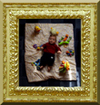Joiner photography and Rubens' late landscapes with a photo by Malcolm Aslett
|
I’m very fond of Rubens landscapes. After he ‘retired’ in the 1630’s he painted a series of large canvases that I think have some things to teach about joiner photography, or, at the very least, the expansion of the field of view of an image and its contents. To start off, here is a joiner of my son lying on a rock in a landscape. If it were described in a sentence the subject might be the boy but the words would witter on and on about other things like the rocks being covered with water, the fine grain of ground stone, a small cascade, a single autumnal red leaf caught at an edge, the brackish tree line...which is to say that details are added and added by dint of turning to take another photograph and adding it to the group. It is not a wide angle shot simply to include these items in a frame and according to an overarching optical principle.. Every photographer knows that feeling of disappointment when they see a scene and grab their camera to take the shot and the scene disappears and becomes limited and unimpressive once they see it through the viewfinder and in the frame - because as people we see a totality before us rather than through Alberti’s imaginary window. The photo through the lens is ok, but we can’t have it all and include the friendly dog to the right or the slender reeds to the left to the same constituency as we are experiencing it. What has this got to do with Rubens? I look at these paintings and feel he is doing the ‘attritional thing’ that a complex joiner requires. He wants the rainbow but he also wants the ducks on the ground and the memory of the stream lapping the bank. He wants the colour in the clouds and the sight of the haymakers and doesn’t want to leave out the girls or the precious detail of the trees in the far distance. It may seem that there is an overriding perspective due to the wedge of trees sharpening to the right and the dirt track coming from bottom left. They provide a certain expected order but the peripheries tell a different story. He ignores the rules to pack his image with a panoply of living details that excite his interest and his eye. Is it a result of having such big canvases to work with? Probably in part. He’s the artist in charge of the inventory. In the other, a View of the Het Steen in the Early Morning there is a range from the dirt and grass of the earth to the pickled clouds and tree tops touched with crusty gold. And while it has been suggested that Rubens built up thsee painting from several sketches to give these scenes a 'montage' effect it is the breadth of his view that strikes the eye. The subject is of his own estate, Het Steen, and these are visions showing a love of what he sees. The rectangle imposes a false association of typical perspectival order. It is seven and a half feet long and Rubens, always a work horse, would have required a good deal of physical effort and movement himself to paint it, to build it, day after day. That ain't no window. That's a house. A photograph is a far less ambitious undertaking. The skimpy ambition of a nice photograph through a single frame does seem rather paltry in the face of these Rubens though. So I enjoy this image of the boy on the rocks and it reminds me that in a tiny way I am following in Rubens’ footsteps. I like that the water is seen in various forms, as cascade, as stream, from above and askance. The detail of rock, grain, leaf and tree in various forms. Peter Paul and Rubens. Good name for a band.
|
 |
 |








